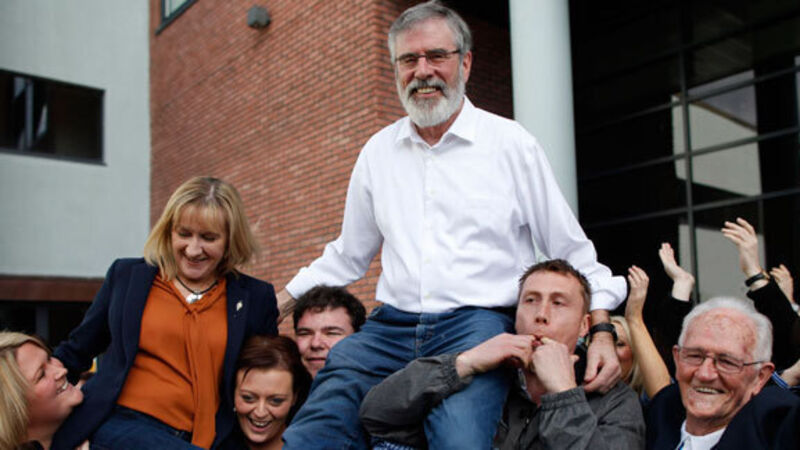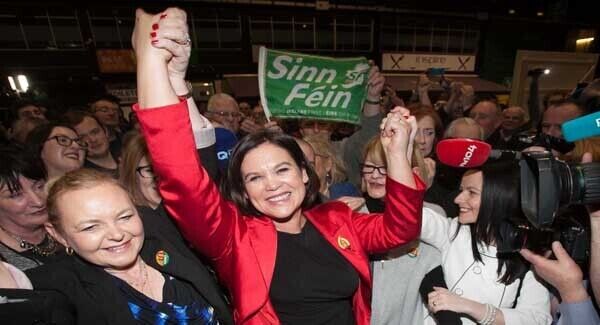#GE16 Analysis: Sinn Féin’s vote a work in progress

The party has continued to build incremental progress in this election.
But the spectacular gains that opinion polls in the lifetime of the outgoing Dáil had suggested Sinn Féin would make, failed to materialise.
In 1991, when Ireland celebrated the 75th anniversary of the Easter Rising, Sinn Féin were, at best, a political fringe movement with not even one seat in the Dáil.
In a generation, that situation has changed utterly. In 1997, Caoimhghín Ó Caoláin became the first non-abstentionist Sinn Féin TD to take a seat in Dáil Éireann since the Civil War.
Peadar Tóibín and supporters at Trim count centre. pic.twitter.com/g8NsVReyTZ
— RTÉ Meath West (@RTEmeathWEST) February 27, 2016
Bar the 2007 election, when Bertie Ahern’s Fianna Fáil made a determined effort to win republican votes from Sinn Féin, Gerry Adams’ party has steadily gained at every single Dáil election.
Looking at this bigger picture, Sinn Féin activists cannot but be happy with the continued progress reflected in the 2016 election results.
In 2011, Sinn Féin enjoyed its then best-ever result since Éamon de Valera and Seán Lemass had split from Sinn Féin to found Fianna Fáil. Mr Adams was elected for the Louth constituency and Sinn Féin won 10% of the vote and 14 Dáil seats.
In 2016, Sinn Féin has surpassed this record.
Despite this achievement, there is a sense that the Sinn Féin campaign under-performed.
An Irish Times/Ipsos MRBI opinion poll in September 2015 put Sinn Féin at 21%, making it the most popular opposition party. Other polls at intervals during the 31st Dáil also suggested Sinn Féin could gain more than 20% of the national vote, which would have materialised into a lot more seats than the number ultimately won by the party in this election.
With a total vote of 9782, @EOBroin is elected in #dubmw alongside @FitzgeraldFrncs with 9028! #ge16 pic.twitter.com/cOG14rAPzs
— Newstalk Elections (@ElectionNT) February 27, 2016
Serious questions will be asked by everyone interested in Irish politics about the accuracy of the opinion polls and the methodologies being deployed.
The final results bear very little resemblance to the recent polls and the scale of both the Fine Gael collapse and the Fianna Fáil surge went largely undetected.
There is also a big argument over polls over-estimating Sinn Féin’s strength.
The party’s strongest vote is in working-class areas where turnout is traditionally low. It is very debatable whether recent opinion polls accurately managed to match party preferences with the likelihood of a vote actually being cast.
Sinn Féin will also believe hostile media coverage restrained their progress in this election. The party was vocal in its complaints about media coverage of news stories regarding the party’s attitude to the Special Criminal Court and the tax affairs of prominent republican, Thomas ‘Slab’ Murphy.
@loreillysf Louise O'Reilly gets elected in Dub Fingal this is one of those moments to be enjoyed and shared#ge16 pic.twitter.com/HKtivN72Kp
— Sinn Féin (@sinnfeinireland) February 28, 2016
The party accused one newspaper of engaging in a “skewed propaganda broadside against Sinn Féin”.
At the same time, Sinn Féin has heatedly complained about RTÉ’s coverage, complaining that the national broadcaster has chosen to air stories with a slant against the party and used these to deduct from Sinn Féin’s electoral airtime.
Sinn Féin’s frustrations were such that Gerry Adams even took to Facebook to present a two-minute video attacking RTÉ and, in particular, its failure to cover his attempts to raise the issue of suicide with a support group in Cork on the campaign trail.
The tensions between RTÉ and Sinn Féin were highlighted in the testy exchanges between Adams and Miriam O’Callaghan during the final leaders’ debate, with the Sinn Féin leader even quizzing the RTÉ presenter about whether she earned over €100,000 and suggesting she should declare a conflict of interest.
While Sinn Féin activists may see a media conspiracy against them, this is not an unusual viewpoint across the political spectrum.

In 2007, Fianna Fáil was convinced that large sections of the media were out to get the party, especially as the first 10 days of the campaign were dominated by issues regarding the personal finances of their then-party leader. Neither Fine Gael nor Labour will believe that the media has done them any favours in this campaign.
In truth, Adams’ performance in the election was mixed. He performed adequately in the debates but, like all of the leaders, he was overshadowed by Micheál Martin. Bertie Ahern has suggested that Adams’ leadership of the party actually cost Sinn Féin 10 seats.
SF's Martin Kenny takes second seat in Sligo/Leitrim. pic.twitter.com/U3K03HHkWe
— Paul Deering (@PaulDeering14) February 28, 2016
While having the height of respect for Ahern’s political judgement, this is not a proposition I buy into. In recognising that Adams remains a huge electoral asset to his party, one need look no further than the Sinn Féin leader’s own constituency of Louth, where he accomplished an extraordinary vote-management feat to secure two seats.
Adams’ deputy leader, Mary Lou McDonald, is also a strong vote-getter. Though this campaign again underlined her popularity, especially with female voters, Sinn Féin will be disappointed not to have made more gains in Dublin.
The major curb on Sinn Féin’s progress is less attributable to media bias or IRA links — which have little influence on younger voters — and is more likely rooted in the emergence of the anti-water charges movement into electoral politics.
Sinn Feins Pearse Doherty is the second #Donegal deputy to be elected #GE16 pic.twitter.com/CIQIPQCnFv
— Catherine Gaffney (@CatherineGaff) February 28, 2016
Many of the left-wing independents, anti-austerity and water protest candidates who have made it into the 32nd Dáil have done so by taking votes that Sinn Féin would have seen previously as its own. Sinn Féin may also have lost some of its softer republican support to a resurgent Fianna Fáil campaign.
Labour’s collapse means Sinn Féin is now the Dáil’s third-biggest party.
The impetus to form a government will be with the two main parties. Even more strongly than their campaign denunciations of each other, Fine Gael and Fianna Fáil have both been unequivocal in their rejection of Sinn Féin. In the past, Éamon Ó Cuív has said Sinn Féin is the most compatible party with Fianna Fáil.
But, with his strong general election performance, it will be Micheál Martin who will be calling all the shots on Fianna Fáil’s next move.
Don’t expect him to be giving Gerry Adams a ring anytime soon.
This won’t unduly bother Sinn Féin’s top strategists. Sentimentalists in the party might want to be in government for the centenary of the Easter Rising.
But the party’s hard-nosed pragmatists will realise that if Fine Gael and Fianna Fáil can be forced into government together, there is a huge opportunity for Sinn Féin to continue its advance.
















